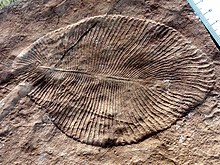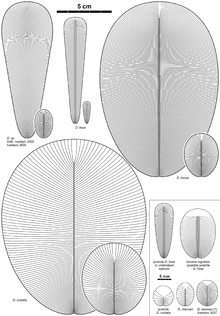狄更逊水母
| Dickinsonia 化石时期:埃迪卡拉纪晚期,
| |
|---|---|

| |
| 澳大利亚出土的Dickinsonia costata模化石 | |
| 科学分类 | |
| 界: | 动物界 Animalia |
| 门: | †前分节动物门 Proarticulata |
| 纲: | †双侧水母纲 Dipleurozoa |
| 科: | †狄更逊水母科 Dickinsoniidae |
| 属: | †狄更逊水母属 Dickinsonia Sprigg, 1947 |
| 模式种 | |
| 肋脉狄更逊水母 Dickinsonia costata Sprigg, 1947
| |
| 种 | |
和一个被加入的物种
| |
| 异名 | |
狄更逊水母(学名:Dickinsonia)又名狄更逊蠕虫、迪金索尼亚虫,是埃迪卡拉纪时代埃迪卡拉生物群中最具标志性的一种生物。其分类地位还不是很明朗,多数研究者认为它是动物,但也有人认为它属于真菌,甚至属于已灭绝的一界。[3]2018年,一个从俄罗斯悬崖挖出的狄更逊水母化石,经研究人员分析成分后发现其中含有胆固醇,证实此类群为地球上已知最古老的动物之一。
名称
狄更逊水母最早由埃迪卡拉生物群的发现者,澳大利亚地质学家斯普里格描述 ,并以他的上级、南澳政府的采矿总监班·迪金森的名字命名。[4]
发现
狄更逊水母的化石最早(1947年)在澳大利亚南部弗林德斯山脉的罗恩斯利石英段(Rawnsley Quartzite)发现,另外也在乌克兰波多里亚德涅斯特河盆地的莫吉廖夫组(Mogilev Formation)[5]、俄罗斯阿尔汉格尔斯克州白海的Lyamtsa、Verkhovka、Zimnegory和Yorga等组,以及乌拉山脉中部的Chernokamen组被发现。[6]这些地层的年代约为5.58亿至5.55亿年前。[7]
“科学杂志”(Science)2018年发布的报告,一个从俄罗斯西北部、白海附近的岩石发现了狄更逊水母的化石,由于形成于黏土和沙砾的混合物中,保存的细胞组织检测出有胆固醇分子的成分。胆固醇作为动物细胞构成细胞膜的基本物质,植物及其他一切生物均是由脂质分子层包裹的细胞构成的,但唯独动物的细胞膜中含有胆固醇。因此,发现胆固醇的存在就意味着狄更逊水母的确是一种动物。不过,这一发现也可能是由污染造成的——比如,工作人员一不小心将手指蹭到了化石上,这一行为会立刻将含有脂质的细胞转移到化石上,使得化石被误判为一种古生物。因此,Jochen Brocks和他的同事们仔细地检查了狄更逊水母化石周围的岩石。这次,他们并没有发现胆固醇,只检测出了豆固醇——这种分子与绿藻有着密切的关系。科学家们表示,这一发现恰恰证明,他们发现的胆固醇属于狄更逊水母化石而非来自污染物——狄更逊水母作为动物的属性被证实了。[8][9]
物种
- D. costata Sprigg, 1947(模式种)[4]
- D. minima Sprigg, 1949[10]
- D. spriggi Harrington et Moore, 1955[11]
- D. elongata Glaessner et Wade, 1966[12]
- D. tenuis Glaessner et Wade, 1966[12]
- D. lissa Wade, 1972[13]
- D. brachina Wade, 1972[13]
- D. menneri Keller 1976(原名为Vendomia menneri Keller 1976[14],2007年由Ivantsov重新分入狄更逊水母属[2]
- D. rex Jenkins, 1992[15]
在这九个被描述的物种中,约只有四或五种是不同的物种。
D. costata(次异名包括 D. minima、D. spriggi 与D. elongata(正模标本)),异构体节较别的物种少且宽。
D. tenuis(次异名为D. brachina),与D. costata类似,但有较多与窄的体节,体呈较长的卵形。
D. lissa,呈长卵形,可长达15公分,具有多且窄的异构体节,头部的体节较身体其他部分的短>
D. menneri(次异名为Vendomia menneri),体型很小,仅8毫米,与D. costata 较幼小的标本十分相似,异构体节不多,差别是D. menneri 的长度较长。
D. rex(原是D. elongata的副模标本),体型可大至1米,除此之外没有明确特征,只因特别庞大的体型而独立为一种,标本不多。被归为本种的标本很可能只是体型较大的D. costata或D. tenuis
描述
狄更逊水母的痕迹只在砂岩层中以印痕化石或铸模化石的形式被发现。标本长度从数毫米至1米皆有,厚度则从几分之一毫米至几毫米[6]。

本种大致呈两侧对称、分节、外形为圆形至卵形,其中一端略为拉长。体节朝两端放射状分布,其长度由整个模型的窄端至宽端递增和有一个肋状的凸面层。两侧的体节被中间的隆起或凹槽分隔,且两侧的体节呈滑移对称而非简单的两侧对称,因此这些体节被称为异构体节[2][16]。滑移对称也出现在与狄更逊水母约莫同时的另一种埃迪卡拉生物斯普里格蠕虫。
狄更逊水母化石似乎保存了一些内部结构,它代表了一种既能消化食物,又能将营养输送、分布到整个有机体内的系统。
移动
伊凡斯和加州大学河滨分校及澳洲南澳博物馆的研究人员分析了近1500块狄更逊水母的化石,以确认牠们能否独自移动。伊凡斯说:“已经有人根据化石证据,猜测这些动物具有移动能力。我们想做的是,根据这些化石的其他特征,排除移动之外的可能性。”
这些化石证据包括了实体化石,以及形似“足迹”的“生痕化石”,都暗示著这些动物独自行动的能力。不过有些科学家指出,这些生物也可能随着古老海流移动到别处。也有科学家认为,“足迹”化石可能是这些生物埋在沉积层死亡分解后的遗迹。
不过伊凡斯的研究团队已经证实,狄更逊水母的确是靠自身移动,而且在牠们一生之中可能迁移至少数十米。伊凡斯表示,如果这些动物是随海流移动的,那么各个标本都会朝向同一个方向;不过化石证据显示,这些动物移动的方向各异。实体化石和生痕化石也透露狄更逊水母特定的移动路线,伊凡斯解释:“如果是死亡动物的残骸,那么遗迹应该随机分散。但是我们观察到单独个体往特定方向移动的痕迹,意味着这些动物是靠着自己身体的力量在移动。”
这些化石也告诉我们,狄更逊水母通常在海底有机层的其中一处觅食,然后在数小时或数天之后开始寻找新的食物来源。一些科学家曾经假设,这些动物是借着肌肉扩张与收缩来移动,新的化石分析也支持这项假说。伊凡斯指出,虽然科学家找到证据显示,有些动物比狄更逊水母更早就会独自移动,但是这些动物体型较小、移动的距离也较短。他补充说:“我们是第一次从化石证据中,观察到动物前往新的地点觅食。”
参考资料
- ^ Hofmann, Hans J. An alternative interpretation of the Ediacaran (Precambrian) chondrophore Chondroplon Wade. Alcheringa. 1988, 12 (4): 315–318. doi:10.1080/03115518808619130.
- ^ 2.0 2.1 2.2 Ivantsov, A. Yu. Small Vendian transversely Articulated fossils. Paleontological Journal. 2007, 41 (2): 113–122 [2015-04-19]. doi:10.1134/S0031030107020013. (原始内容存档于2020-04-25).
- ^ Bobrovskiy, Ilya; Hope, Janet M.; Ivantsov, Andrey; Nettersheim, Benjamin J.; Hallmann, Christian; Brocks, Jochen J. Ancient steroids establish the Ediacaran fossil Dickinsonia as one of the earliest animals. Science. 20 September 2018, 361 (6408): 1246–1249. doi:10.1126/science.aat7228.
- ^ 4.0 4.1 Sprigg, Reg C. Early Cambrian (?) Jellyfishes from the Flinders Ranges, South Australia (PDF). Trans. Roy. Soc. S. Aust. 1947, 71: 212–24. (原始内容 (PDF)存档于2007-09-29).
- ^ Fedonkin, M. A. Non-skeletal fauna of Podoloia, Dniester River valley. Velikanov, V. A.; Asse]eva, E. A. and Fedonkin, M. A. (编). The Vendian of the Ukraine. Kiev: Naukova Dumka. 1983: 128–139 (俄语).
- ^ 6.0 6.1 Fedonkin M. A., Gehling J. G., Grey K., Narbonne G. M., and Vickers-Rich P. The Rise of Animals. Evolution and Diversification of the Kingdom Animalia. Johns Hopkins University Press. 2007: 326. ISBN 978-0-8018-8679-9.
- ^ Grazhdankin, Dima. Patterns of distribution in the Ediacaran biotas: facies versus biogeography and evolution (PDF). Palæobiology. 2004, 30 (2): 203–221 [2007-03-08]. doi:10.1666/0094-8373(2004)030<0203:PODITE>2.0.CO;2. (原始内容存档 (PDF)于2011-07-26).
- ^ Storm.mg. 5億年前的動物老祖宗長這樣!狄更遜水母化石中發現膽固醇分子 榮登地球最古老動物-風傳媒. www.storm.mg. 2018-09-21 [2023-09-17]. (原始内容存档于2020-11-25) (中文(台湾)).
- ^ 欧敬洛. 一個發現證明一切 「狄更遜水母」刷新地球已知最古老動物排行榜. 香港01. 2018-09-22 [2023-09-17]. (原始内容存档于2021-07-27) (中文(香港)).
- ^ Sprigg, R.C. Early Cambrian "Jellyfishes" of Ediacara, South Australia and Mount John, Kimberley District, Western Australia (PDF). Transactions of The Royal Society of South Australia. 1949, 73: 72–99.[永久失效链接]
- ^ Harrington, N. J.; Moore. R. C. Kansas Pennsylvanian and other jellyfishes. Bull. Kansas Geol. Surv. 1955, 114 (5): 153–163 [2018-11-11]. (原始内容存档于2016-03-05).
- ^ 12.0 12.1 Glaessner, M.F.; Wade, M. The late Precambrian fossils from Ediacara, South Australia (PDF). Palaeontology. 1966, 9 (4): 599 [2015-04-19]. (原始内容存档 (PDF)于2013-09-22).
- ^ 13.0 13.1 Wade, M. Dickinsonia: Polychaete Worms from the Late Precambrian Ediacara Fauna, South Australia. Mem. Queensl. Mus. 1972, 16 (2): 171–190.
- ^ B. M. Keller and M. A. Fedonkin. New Records of Fossils in the Valdaian Group of the Precambrian on the Syuz’ma River (PDF). Izv. Akad. Nauk SSSR, Ser. Geol. 1976, 3: 38–44. (原始内容 (PDF)存档于2007-09-27) (俄语).
- ^ Jenkins, R. J. F. Functional and ecological aspects of Ediacarian assemblages. Lipps, J., and Signor, P. W. (编). Origin and early evolution of the Metazoa. New York: Springer. 1992: 131–176. ISBN 0-306-44067-9. OCLC 231467647.
- ^ A. Yu Ivantsov. Feeding traces of proarticulata—the Vendian metazoa. Paleontological Journal. 2011-05-01, 45 (3): 237–248 [2018-04-02]. ISSN 0031-0301. doi:10.1134/s0031030111030063. (原始内容存档于2019-06-11) (英语).
| ||||||||||||||||||||||||||||||||||||||||||||||||||||
|
Text is available under the CC BY-SA 4.0 license; additional terms may apply.
Images, videos and audio are available under their respective licenses.

